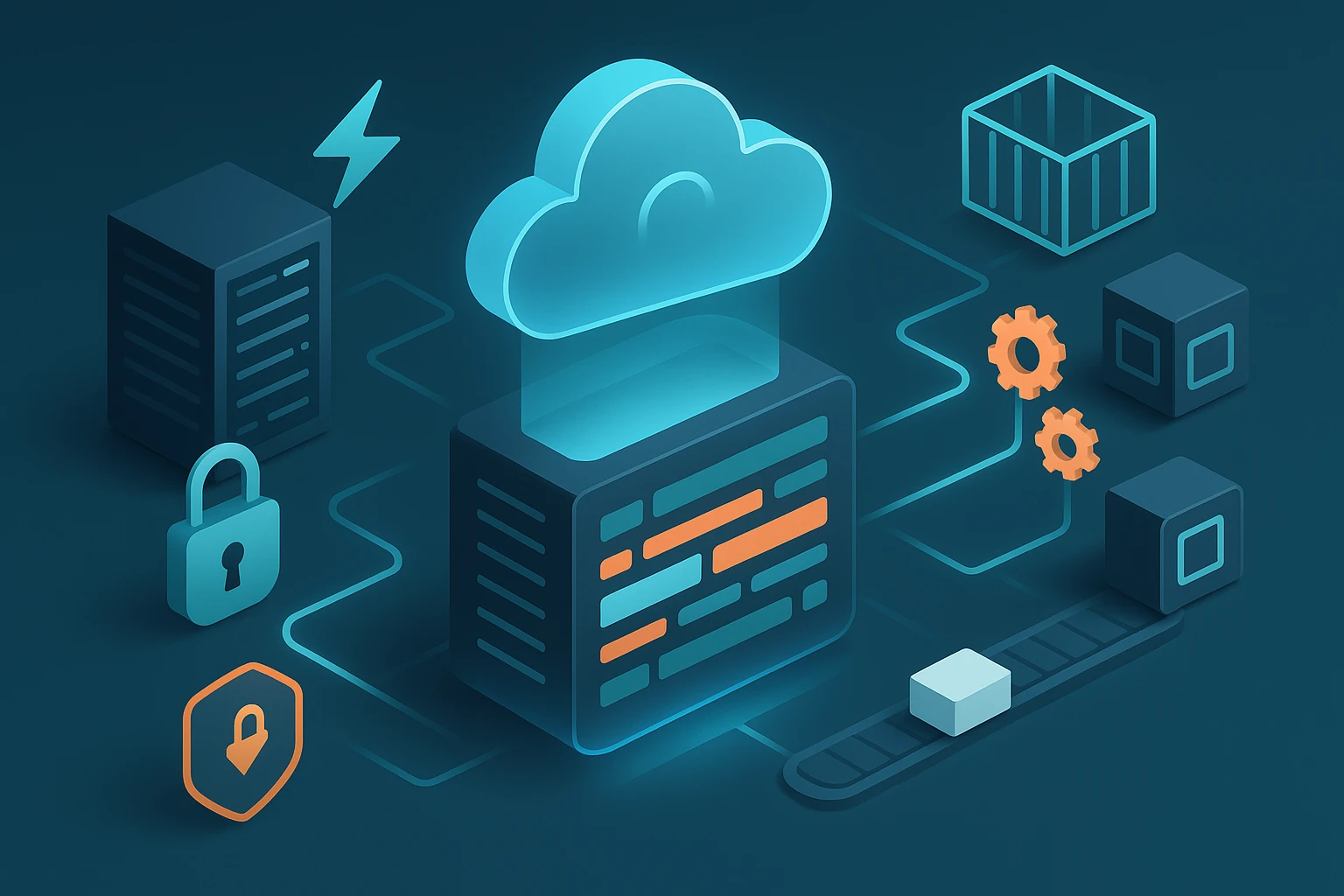Infrastructure as Code Explained (IaC Basics)
Diagram: of Infrastructure as Code: cloud, servers, code, pipelines linked by arrows to show automated provisioning, versioned configuration, and repeatable, auditable deployments.

Sponsor message — This article is made possible by Dargslan.com, a publisher of practical, no-fluff IT & developer workbooks.
Why Dargslan.com?
If you prefer doing over endless theory, Dargslan’s titles are built for you. Every workbook focuses on skills you can apply the same day—server hardening, Linux one-liners, PowerShell for admins, Python automation, cloud basics, and more.
In today's rapidly evolving technological landscape, the way we manage and deploy infrastructure has fundamentally transformed. Organizations that once spent weeks provisioning servers and configuring networks can now accomplish the same tasks in minutes. This shift represents more than just efficiency gains—it's a complete reimagining of how we approach infrastructure management, enabling teams to move faster, reduce errors, and scale with unprecedented agility.
Infrastructure as Code represents a methodology where infrastructure configuration is managed through machine-readable definition files rather than physical hardware configuration or interactive configuration tools. This approach promises to bridge the gap between development velocity and operational stability, offering perspectives from automation enthusiasts, security professionals, and business leaders alike.
Throughout this exploration, you'll discover the core principles that make this approach revolutionary, understand the practical tools and techniques that bring these concepts to life, and learn how to evaluate whether this methodology aligns with your organization's needs. Whether you're a seasoned operations professional or new to infrastructure management, you'll gain actionable insights into transforming how your organization provisions and manages its technical foundation.
Understanding the Foundation
The traditional approach to infrastructure management involved manual processes: administrators logging into servers, configuring settings through graphical interfaces, and documenting changes in spreadsheets or wikis. This method, while familiar, introduced inconsistencies, made scaling difficult, and created knowledge silos within organizations. When infrastructure exists as code, these challenges dissolve into systematic, repeatable processes.
At its essence, treating infrastructure as code means writing declarative or imperative definitions that describe the desired state of your systems. These definitions live in version control systems alongside application code, undergo the same review processes, and benefit from the same collaborative workflows that have revolutionized software development. The infrastructure becomes self-documenting, with every change tracked and every configuration decision preserved in the repository's history.
"The single most transformative aspect is the ability to recreate entire environments from a single command, eliminating the 'works on my machine' syndrome that has plagued operations teams for decades."
This paradigm shift brings infrastructure management into alignment with modern software engineering practices. Teams can now apply continuous integration and continuous deployment principles to infrastructure changes, test modifications in isolated environments before production deployment, and roll back problematic changes with the same ease as reverting a code commit. The infrastructure becomes as flexible and maintainable as the applications it supports.
Core Principles and Philosophies
Several fundamental principles underpin successful implementation. Understanding these concepts helps teams avoid common pitfalls and maximize the benefits of this approach. Each principle represents years of collective learning from organizations that have navigated this transformation.
Declarative vs. Imperative Approaches
The distinction between declarative and imperative styles represents one of the most important conceptual decisions. Declarative approaches focus on describing what the final state should be, allowing the tooling to determine how to achieve that state. You specify that you need three web servers with specific configurations, and the system figures out whether to create new instances, modify existing ones, or leave everything unchanged.
Imperative approaches, conversely, require explicit step-by-step instructions. You write procedures that create servers, install software, configure settings, and establish connections. While this offers more granular control, it also places the burden of state management on your code. The choice between these approaches significantly impacts how you structure your infrastructure definitions and how your team interacts with them.
| Aspect | Declarative Approach | Imperative Approach |
|---|---|---|
| Focus | Desired end state | Step-by-step procedures |
| State Management | Tool-managed | User-managed |
| Idempotency | Built-in | Must be implemented |
| Learning Curve | Steeper initially | More intuitive at first |
| Flexibility | Limited by abstraction | Highly flexible |
| Maintenance | Generally simpler | Can become complex |
Idempotency and Consistency
Idempotency ensures that applying the same configuration multiple times produces identical results. This property proves crucial for maintaining stable environments and enabling confident deployments. When infrastructure definitions are idempotent, teams can repeatedly apply configurations without fear of unintended side effects or cumulative errors.
Consistency extends beyond individual resources to encompass entire environments. Development, staging, and production environments should differ only in specific, intentional ways—such as scale or performance characteristics. By defining these environments through code, organizations eliminate configuration drift and ensure that testing occurs in conditions that accurately reflect production.
Version Control Integration
Storing infrastructure definitions in version control systems transforms how teams collaborate and manage changes. Every modification creates an auditable record, complete with author information, timestamps, and explanatory commit messages. This historical record becomes invaluable when investigating issues, understanding system evolution, or complying with regulatory requirements.
"Version control for infrastructure isn't just about tracking changes—it's about enabling the same collaborative workflows that have made distributed software development possible."
Branching strategies allow teams to develop and test infrastructure changes in isolation before merging them into main branches. Pull requests facilitate peer review, ensuring that multiple team members examine changes before they affect shared environments. Tags mark significant milestones, making it simple to reference or recreate specific infrastructure states.
Essential Tools and Technologies
The ecosystem offers numerous tools, each with distinct philosophies, strengths, and ideal use cases. Understanding these options helps teams select technologies that align with their requirements, existing skills, and organizational culture.
Configuration Management Tools
Traditional configuration management tools focus on maintaining desired states on existing servers. These tools excel at ensuring consistent configurations across large server fleets, managing software installations, and enforcing security policies. They typically use agent-based or agentless architectures to communicate with managed systems.
Ansible takes an agentless approach, using SSH connections to configure remote systems. Its playbooks use YAML syntax to define tasks, making them relatively approachable for newcomers. The tool's simplicity and low barrier to entry have made it popular for teams beginning their automation journey.
Chef and Puppet represent more mature, agent-based solutions. They use domain-specific languages to define configurations and maintain client-server architectures for managing large deployments. These tools offer sophisticated features for complex environments but require more significant learning investments.
Provisioning Tools
Provisioning tools focus on creating and managing infrastructure resources themselves—virtual machines, networks, storage, and cloud services. These tools interact directly with provider APIs to create, modify, and destroy resources based on code definitions.
Terraform has emerged as a leading multi-cloud provisioning tool. Its declarative configuration language describes infrastructure resources across various providers using a consistent syntax. The tool maintains state files that track real-world resources, enabling it to calculate necessary changes when configurations are modified. This state management capability makes Terraform particularly effective for complex, multi-resource deployments.
CloudFormation provides similar capabilities specifically for AWS environments. As a native AWS service, it offers deep integration with AWS features and services. Templates written in JSON or YAML define stacks of related resources that CloudFormation provisions and manages as units.
Pulumi represents a newer approach, allowing teams to define infrastructure using general-purpose programming languages like Python, TypeScript, or Go. This approach leverages existing programming knowledge and enables sophisticated logic within infrastructure definitions, though it also introduces additional complexity.
Container Orchestration
Container orchestration platforms like Kubernetes have their own infrastructure-as-code paradigms. Kubernetes manifests define desired states for containerized applications, including deployments, services, and configuration. Tools like Helm package these manifests into reusable charts, while operators extend Kubernetes to manage complex applications using custom resources.
"The convergence of infrastructure provisioning and application deployment in container platforms represents the next evolution in infrastructure management."
Implementation Strategies
Successfully adopting these practices requires more than selecting tools—it demands thoughtful planning, gradual implementation, and cultural adaptation. Organizations that rush implementation often encounter resistance, confusion, and suboptimal results.
Starting Small and Scaling
Beginning with a limited scope allows teams to learn without risking critical systems. Consider automating a non-production environment first, or selecting a single application stack for initial implementation. This contained approach provides valuable learning opportunities while limiting potential impact from mistakes.
As confidence and expertise grow, gradually expand the scope. Document lessons learned, refine processes, and develop organizational standards based on practical experience. This incremental approach builds momentum and demonstrates value, making it easier to secure resources and support for broader adoption.
Modularization and Reusability
Well-designed infrastructure code emphasizes modularity and reusability. Rather than creating monolithic definitions that describe entire environments, break configurations into logical components that can be composed and reused. A module might define a standard web server configuration, a database cluster, or a networking setup.
These modules become building blocks that teams can assemble into complete environments. Parameters allow customization without duplicating code, while interfaces define clear contracts between modules. This modular approach reduces duplication, simplifies maintenance, and promotes consistency across environments.
Testing and Validation
Infrastructure code benefits from the same testing practices that ensure application quality. Several testing levels provide comprehensive coverage:
- Syntax validation catches basic errors before execution, verifying that configurations conform to expected formats and structures
- Unit tests validate individual modules in isolation, ensuring they produce expected outputs given specific inputs
- Integration tests verify that modules work correctly together, catching interface mismatches and interaction issues
- End-to-end tests provision actual infrastructure in test environments, validating that configurations produce functional systems
- Policy tests enforce organizational standards, security requirements, and compliance rules
Automated testing pipelines execute these tests whenever infrastructure code changes, providing rapid feedback and preventing problematic changes from reaching production. This testing infrastructure becomes as important as the infrastructure code itself.
Security and Compliance Considerations
Managing infrastructure through code introduces new security considerations while also enabling more robust security practices. Understanding these implications helps organizations implement appropriate safeguards.
Secrets Management
Infrastructure code often requires sensitive information—passwords, API keys, certificates, and encryption keys. Storing these secrets directly in code repositories creates severe security risks. Instead, organizations should use dedicated secrets management solutions that encrypt sensitive data and control access through authentication and authorization mechanisms.
Tools like HashiCorp Vault, AWS Secrets Manager, or Azure Key Vault provide secure storage and access controls for secrets. Infrastructure code references these secrets without containing them directly, maintaining security while enabling automation. Rotation policies ensure secrets change regularly, limiting the impact of potential compromises.
"The most dangerous vulnerability in infrastructure-as-code isn't in the tools themselves—it's in hardcoded credentials accidentally committed to version control."
Access Control and Audit
Version control systems provide natural audit trails for infrastructure changes, but organizations must also control who can approve and apply changes. Branching strategies and pull request workflows create approval gates, ensuring multiple team members review significant changes before implementation.
Role-based access control limits which team members can modify different infrastructure components. Developers might have broad access to development environments but restricted access to production. These controls prevent unauthorized changes while enabling teams to work efficiently.
Compliance as Code
Regulatory requirements and organizational policies can be encoded as automated tests that validate infrastructure configurations. Tools like Open Policy Agent allow teams to write policies as code, automatically checking that infrastructure definitions comply with requirements before deployment.
This approach transforms compliance from periodic manual audits into continuous automated validation. Non-compliant configurations are caught immediately, often before they're even proposed for review. The policies themselves become versioned artifacts that evolve alongside infrastructure code.
| Security Concern | Traditional Approach | Code-Based Approach | Best Practice |
|---|---|---|---|
| Secrets Storage | Stored on servers or in documentation | Risk of exposure in repositories | Dedicated secrets management systems |
| Change Authorization | Manual approval processes | Pull request reviews | Automated workflows with approval gates |
| Compliance Validation | Periodic manual audits | Automated policy testing | Continuous compliance checking |
| Access Control | Server-level permissions | Repository permissions | Role-based access with environment separation |
| Audit Trail | Log files and change tickets | Git commit history | Integrated logging with version control |
Organizational and Cultural Impacts
Technical transformation inevitably drives organizational change. Teams must adapt workflows, develop new skills, and often reconsider traditional role boundaries. Understanding these human dimensions proves as important as mastering the technical aspects.
Breaking Down Silos
Traditional organizations often separate development and operations teams, creating handoff points that slow delivery and obscure accountability. When infrastructure becomes code, these boundaries blur productively. Developers gain more visibility into and control over the environments running their applications, while operations teams adopt software engineering practices.
This convergence doesn't eliminate specialization—infrastructure expertise remains valuable—but it does require increased collaboration. Cross-functional teams that include both development and operations perspectives make better decisions and move faster than siloed groups communicating through tickets and meetings.
Skill Development and Training
Team members need new skills to work effectively with infrastructure code. Operations professionals must become comfortable with version control, code review, and testing practices. Developers need to understand infrastructure concepts, cloud services, and deployment processes. Organizations should invest in training, mentorship, and time for experimentation.
This learning curve represents an investment, not a cost. Teams that develop these skills become more versatile, productive, and valuable. The initial productivity dip during learning phases pays dividends through increased velocity and reduced errors over time.
"The hardest part of infrastructure-as-code adoption isn't learning the tools—it's unlearning the assumptions and practices that made sense in a manual world but create friction in an automated one."
Measuring Success
Organizations need metrics to evaluate whether their implementation delivers expected benefits. Useful measurements include:
- ⚡ Deployment frequency: how often teams can safely deploy infrastructure changes
- ⏱️ Lead time: duration from deciding on a change to having it running in production
- 🔄 Recovery time: how quickly teams can restore service after problems occur
- 📉 Change failure rate: percentage of changes that require remediation
- ✅ Environment consistency: degree of configuration alignment across environments
These metrics provide objective evidence of improvement and help identify areas needing attention. They also demonstrate value to stakeholders who may question the investment required for transformation.
Common Challenges and Solutions
Every organization implementing these practices encounters obstacles. Anticipating common challenges and understanding proven solutions accelerates success and prevents discouragement.
State Management Complexity
Tools that maintain state files must keep these files synchronized with actual infrastructure. State drift—when real-world resources diverge from state files—creates confusion and potential errors. Manual changes made outside the infrastructure code workflow are the primary cause of drift.
Preventing drift requires discipline and appropriate tooling. Lock down production environments to prevent manual changes, implement monitoring to detect drift when it occurs, and establish processes for reconciling discrepancies. Some teams schedule regular drift detection runs, automatically creating tickets when inconsistencies appear.
Handling Existing Infrastructure
Organizations rarely start with blank slates. Existing infrastructure must be either imported into code management or gradually replaced. Import tools can generate code from existing resources, though the resulting code often requires refinement. Alternatively, teams can adopt a strangler pattern, gradually replacing old infrastructure with code-managed resources.
This migration process demands patience. Attempting to convert everything simultaneously typically leads to problems. Instead, prioritize based on risk, value, and complexity. Start with less critical systems to build confidence before tackling core infrastructure.
Balancing Flexibility and Standardization
Organizations benefit from standardized infrastructure patterns, but excessive standardization stifles innovation and creates frustration. Finding the right balance requires ongoing dialogue between teams with different needs and perspectives.
Consider establishing golden paths—well-supported, standardized approaches for common scenarios—while allowing teams to diverge when they have good reasons. Document both the standards and the process for requesting exceptions. This approach provides consistency without creating bureaucratic rigidity.
"The goal isn't to eliminate all variation—it's to make intentional variation visible and justified while eliminating accidental inconsistency."
Advanced Patterns and Practices
As teams mature in their practice, they can adopt more sophisticated patterns that further improve reliability, efficiency, and capabilities.
GitOps Workflows
GitOps extends infrastructure-as-code principles by making Git repositories the single source of truth for both infrastructure and application definitions. Automated systems continuously monitor repositories and automatically apply changes when definitions are updated. This approach creates a declarative, auditable deployment process where every change flows through version control.
Pull requests become deployment mechanisms—merging a pull request automatically triggers deployment. Rollbacks become as simple as reverting commits. This tight integration between version control and deployment simplifies operations while maintaining rigorous change control.
Multi-Environment Management
Managing multiple environments—development, staging, production, and potentially customer-specific environments—requires careful organization. Successful approaches typically use one of several patterns:
Workspace-based separation uses a single codebase with different state files for each environment. Variables and configuration files customize behavior for each environment. This approach keeps code consistent but requires discipline to manage environment-specific values.
Directory-based separation organizes code into directories for each environment, with shared modules extracted into common locations. This provides clearer separation but can lead to duplication if not carefully managed.
Repository-based separation uses entirely separate repositories for different environments, with changes promoted through pull requests or automated processes. This maximizes isolation but complicates keeping environments synchronized.
Disaster Recovery and Business Continuity
Infrastructure-as-code dramatically simplifies disaster recovery planning. Because infrastructure definitions are versioned and stored separately from the infrastructure itself, organizations can recreate entire environments in different regions or even different cloud providers.
Regular disaster recovery tests become practical—spin up complete environments in alternate locations, verify functionality, then tear them down. These tests validate not just the infrastructure code but also the team's ability to execute recovery procedures under pressure.
Future Trends and Developments
The field continues evolving rapidly, with several trends shaping its future direction. Understanding these developments helps organizations make forward-looking decisions.
AI-Assisted Infrastructure Management
Machine learning models are beginning to assist with infrastructure management tasks. These systems can suggest optimizations, predict capacity needs, detect anomalies, and even generate infrastructure code from high-level descriptions. While still emerging, these capabilities promise to make infrastructure management more accessible and efficient.
Increased Abstraction
Tools continue moving toward higher levels of abstraction, hiding infrastructure complexity behind simpler interfaces. Platform engineering teams create internal platforms that abstract away low-level details, allowing application teams to provision resources without deep infrastructure knowledge. This democratization of infrastructure management accelerates development while maintaining appropriate controls.
Policy-Driven Infrastructure
Organizations are increasingly encoding business requirements, security policies, and compliance rules as machine-readable policies that automatically validate infrastructure configurations. This shift transforms governance from manual review processes into automated, continuous validation that catches issues early and provides immediate feedback.
"The future of infrastructure management isn't about writing better code—it's about writing less code by leveraging higher-level abstractions and intelligent automation."
Making the Decision
Determining whether to adopt these practices requires honest assessment of organizational readiness, needs, and constraints. Several factors should influence this decision.
When It Makes Sense
Organizations benefit most from infrastructure-as-code when they:
- Manage complex, multi-component infrastructure that changes frequently
- Operate multiple environments that should remain consistent
- Need to scale infrastructure up or down regularly
- Face compliance requirements demanding detailed change tracking
- Experience problems from manual configuration errors
- Want to enable developers to self-service infrastructure provisioning
When to Proceed Cautiously
Some situations warrant careful consideration before full adoption:
- Very small, stable infrastructure that rarely changes may not justify the investment
- Organizations lacking version control expertise should build foundational skills first
- Highly regulated environments may require extensive validation before automation
- Legacy systems with complex dependencies might need gradual migration approaches
Even in these scenarios, some level of automation typically proves valuable. The question becomes one of scope and pace rather than whether to adopt these practices at all.
Getting Started Practically
For organizations ready to begin, a structured approach increases the likelihood of success. Consider this progression:
Phase One: Foundation Building — Select a pilot project with limited scope but real value. Choose tools that align with your infrastructure and team skills. Establish version control practices and basic workflows. Focus on learning and documentation rather than perfection.
Phase Two: Expansion and Refinement — Apply lessons from the pilot to additional projects. Develop organizational standards and best practices. Build shared modules and establish testing practices. Invest in training and skill development.
Phase Three: Maturation — Implement advanced patterns like GitOps workflows. Establish comprehensive testing and validation. Create self-service platforms for common use cases. Measure and optimize based on meaningful metrics.
This phased approach builds momentum while managing risk. Each phase delivers value while preparing the organization for subsequent phases.
How does infrastructure-as-code differ from traditional configuration management?
Traditional configuration management focuses on maintaining desired states on existing servers, while infrastructure-as-code encompasses provisioning the infrastructure itself—creating networks, virtual machines, and cloud resources. Configuration management tools like Ansible or Puppet excel at ensuring consistent configurations, whereas infrastructure-as-code tools like Terraform handle resource creation and lifecycle management. Modern practices often combine both approaches, using provisioning tools to create infrastructure and configuration management tools to maintain it.
What happens if someone makes manual changes to infrastructure managed through code?
Manual changes create state drift, where actual infrastructure diverges from code definitions. Most tools detect this drift during subsequent operations, either warning about discrepancies or attempting to reconcile them. Organizations should establish policies preventing manual changes to code-managed infrastructure, implementing monitoring to detect drift, and creating processes for emergency situations where manual intervention becomes necessary. Some teams run regular drift detection scans and automatically create remediation tickets.
Can infrastructure-as-code work with existing legacy systems?
Yes, though the approach varies by situation. Many tools offer import functionality that generates code from existing resources, though this code often requires refinement. Alternatively, organizations can adopt a gradual migration strategy, managing new infrastructure through code while legacy systems remain manually managed. As legacy systems are modernized or replaced, they transition to code management. This hybrid approach allows organizations to gain benefits without requiring immediate wholesale changes.
How do teams handle secrets and sensitive information in infrastructure code?
Secrets should never be stored directly in infrastructure code or version control. Instead, organizations use dedicated secrets management systems like HashiCorp Vault, AWS Secrets Manager, or Azure Key Vault. Infrastructure code references these secrets through secure mechanisms without containing the actual values. Additionally, teams should implement automated scanning to detect accidentally committed secrets, use environment variables for sensitive values during development, and establish clear policies about secret handling.
What skills do team members need to work effectively with infrastructure-as-code?
Teams need a combination of infrastructure knowledge and software engineering practices. Essential skills include understanding version control systems (particularly Git), familiarity with at least one infrastructure-as-code tool, knowledge of the target infrastructure (cloud platforms, networking, etc.), and appreciation for software development practices like testing and code review. Operations professionals must become comfortable with development workflows, while developers need to understand infrastructure concepts. Organizations should invest in training and create opportunities for cross-functional learning.
How long does it typically take to see benefits from infrastructure-as-code adoption?
Organizations often see initial benefits within weeks of starting a pilot project—reduced provisioning time, fewer configuration errors, and better documentation. However, realizing full benefits typically requires several months as teams develop expertise, establish practices, and expand coverage. The learning curve means productivity may initially decrease before improving significantly. Most organizations report substantial returns within six to twelve months, with benefits continuing to compound as practices mature and coverage expands.




